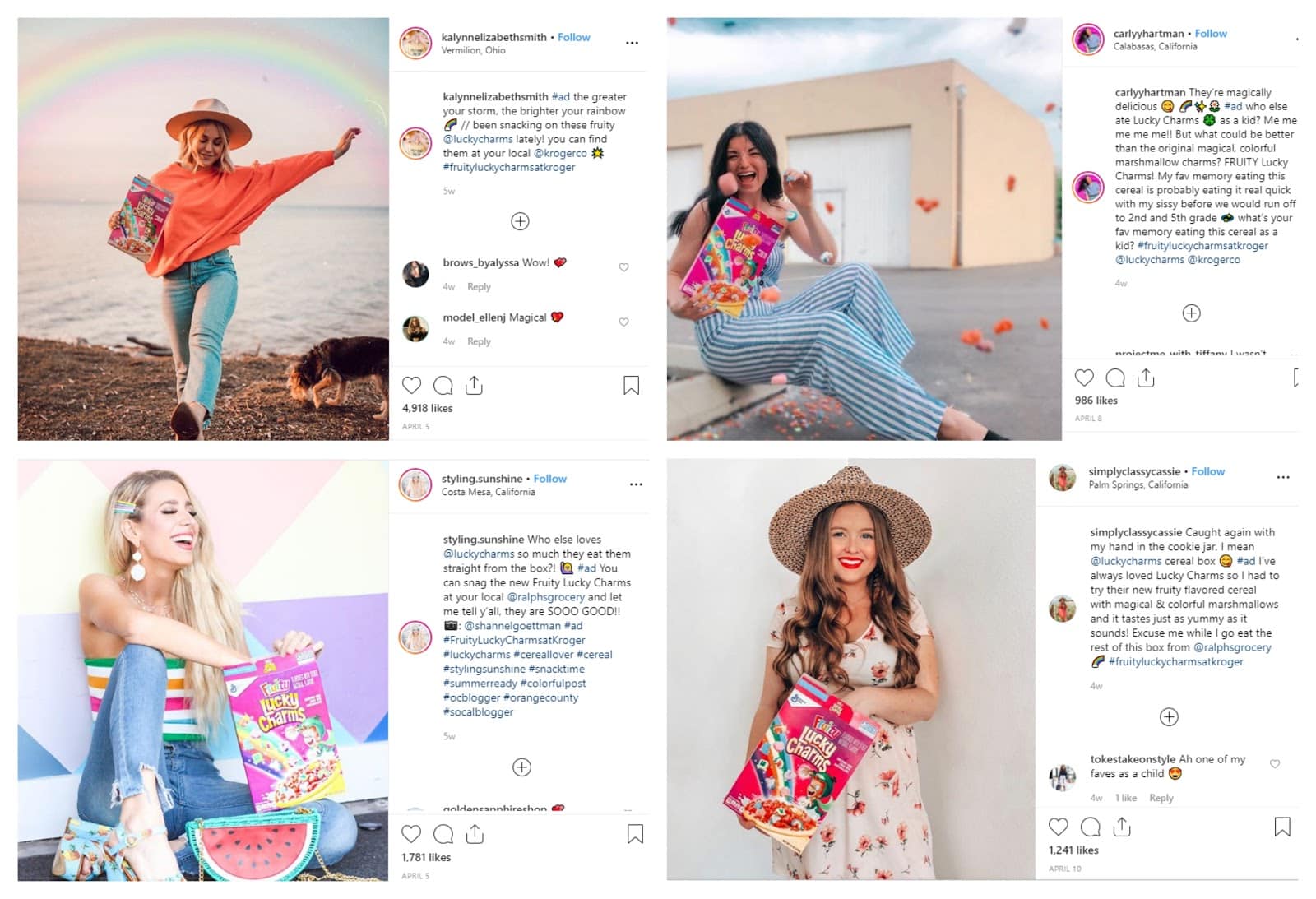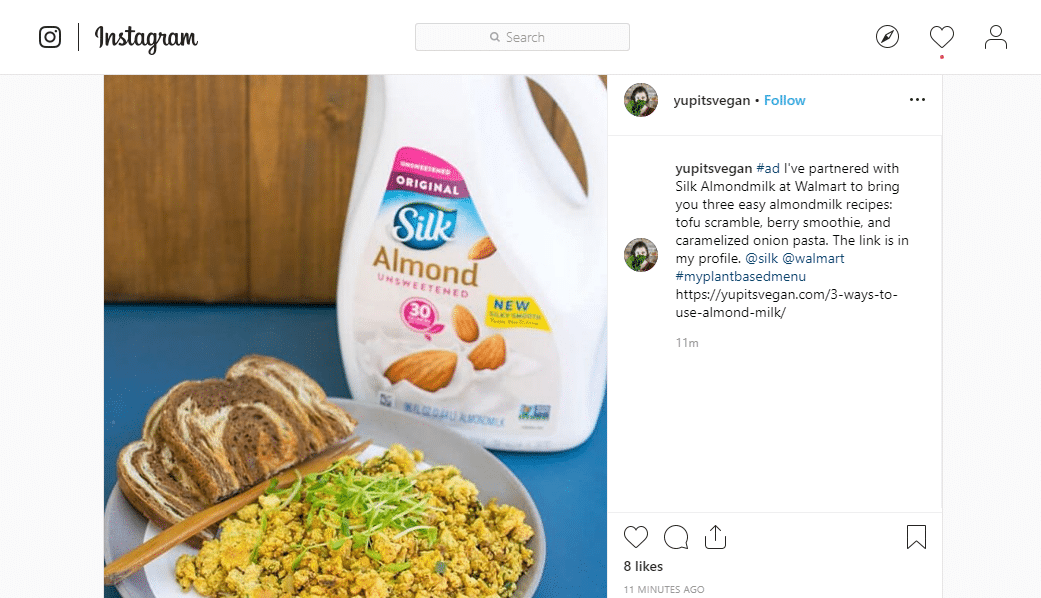When you go on Instagram, Twitter, YouTube, or any other popular social network, influencer marketing is hard to miss – especially because the number of social media influencers keeps growing. And influencer marketing isn’t just hype. Brands that use this strategy properly reap significant rewards, and will continue to do so in the years to come.
What are the essential influencer marketing best practices that will help you reap the best ROI from influencer campaigns? Read on to find out.
Why does influencer marketing work?
Influencer marketing is effective because it is rooted in expert recommendations. Influencers are authorities in a certain field or niche, within a certain audience, or both. So, when influencers show products to their audience, on their own social media accounts, their audience trusts their opinion far more than traditional advertising.
- Only 33% of customers trust traditional ads, but over half of customers rely on influencer recommendations when making purchasing decisions.
- Digital Marketing Institute reports that 60% of consumers would consider purchasing an influencer-promoted product in-store and that 40% have actually purchased a product after seeing an influencer use it on social media.
Brands trust influencer marketing as well.
- According to Social Media Today, 94% of brands who use influencer marketing find it an effective practice, and influencer marketing can generate up to 11 times the ROI of traditional advertising.
- It’s projected that businesses will spend at least $10 billion on influencer marketing in 2020.
So, creating an influencer marketing campaign that follows best practices is invaluable – it will help generate awareness for your brand, and send new customers your way!
Best practices for influencer marketing
Now that you know how powerful influencer marketing can be, it’s time to examine the best practices for brands to follow when developing and running influencer marketing campaigns. We’ll cover selecting and contacting influencers, setting guidelines, measuring the ROI of your campaign, and compensating influencers.
First, let’s start out with some general influencer marketing best practices.
1. Emphasize authenticity
Consumers see right through “salesy” endorsements, but when an influencer uses their own genuine voice to tell a story, their audience will listen. According to Econsultancy, 61% of consumers prefer influencers who create authentic, engaging content. The best influencers will show the value of a product by demonstrating how they use it in real life.
2. Plan to work with multiple influencers at once
There truly is strength in numbers when it comes to working with influencers. Hiring multiple influencers for the same campaign will increase your reach and engagement – and show multiple audiences multiple unique perspectives of your brand.
And choosing several micro-influencers (influencers with smaller follower counts) often works better than choosing one higher-profile influencer, since micro-influencers’ communities are so tight-knit.
Micro-influencers @kalynnelizabethsmith, @carlyyhartman, @styling.sunshine, and @simplyclassycassie all promote Fruity Lucky Charms at Kroger.
3. Personalize outreach emails and messages
Once you’ve identified the influencers you want to work with, personalize each email and/or message. This is your opportunity to show how a partnership with your brand will offer value to the individual influencer and to build a relationship with them. Influencers will usually ignore copied-and-pasted emails, but a meaningful email will make them much more likely to reply.
Choosing and contacting influencers
If you want your influencer program to work, you have to choose the right people to help you. These people become the voice of your brand and help build that relationship with their audience. Here are some tips for choosing wisely as you screen potential influencers.
1. Choose influencers who are experts in your brand’s niche
Their authority will make it easier for their audience to trust them when they recommend your product. For example, an Instagramming runner is a great choice to promote athletic shoes, and a kid YouTuber will be right at home showing off a new toy!
Vegan food blogger Shannon (@yupitsvegan) is a great fit to promote Silk Almond Milk on her Instagram and blog.
2. Choose influencers who align with your brand, and who can easily reach your brand’s target audience
The best influencers will only promote a product if they think it fits in with their own brand and offers value to their own audience. Conversely, an influencer’s audience can easily detect if a sponsored post seems out-of-character for that person. For example, it would be way out-of-place for a 14-year-old YouTube star to promote baby food. However, a mommy blogger with a 6-month-old is the perfect choice to promote this product!
3. Choose influencers who are content creation experts on the social media platform(s) your audience frequents
For example, if you’re marketing to audiences who stay on top of the latest and greatest social media trends, choose an influencer who taps into the trends like a natural. If you’re marketing tech products, video games, or any other product where live demonstrations are beneficial, find niche YouTubers who can show off the products like a pro.
4. Set goals for your influencer marketing campaign, and choose influencers who will help achieve these goals
Is your goal to change the way people think about your brand? To drive conversions? To increase sales in a certain market? To generate brand awareness?
Influencers’ audience and niche are crucial to how well they can help you achieve your goals, but so are other factors. For example, if you’re aiming to gain new customers, choosing an influencer who hasn’t already posted about your brand may be helpful. Or, if you’re a US brand who just started shipping internationally, and you have a goal of increasing brand awareness and sales in the UK, choosing a UK influencer in your niche is key.
5. Prioritize engagement
The number of people that an influencer’s post reaches isn’t everything. Engagement or the interaction an influencer’s post receives the post’s relative number of likes, comments, and shares is a better measure of the post’s success. So, pick influencers whose followers are engaged!
6. Never underestimate micro-influencers
Micro-influencers have less than 100,000 followers, so their reach is not as great as that of macro-influencers or celebrities. However, micro-influencers receive the highest relative engagement from their followers, when compared with larger influencers and at a fraction of the price. Micro-influencers also deliver authenticity you can rely on. In fact, their followers trust them like friends. 82% of consumers are highly likely to follow a recommendation from a micro-influencer, and 61% of consumers say that micro-influencers produce the most relatable content.
7. Use influencer marketing software to pinpoint the right influencers for your brand
Influencer marketing software lets you filter influencers by demographics such as age; niche; location; the number of followers; keywords; hashtags; follower demographics; and engagement rates. With the right software, you can even find influencers who are relevant to your brand, but who haven’t yet posted about your brand yet. Plus, once you’ve found the right influencers, the software can help you manage your influencer campaign.
8. Check influencers’ metrics to make sure their followers are genuine
Some influencers buy fake followers (follows from accounts not run by genuine humans) to make their audiences look bigger than they are. Fake followers can damage your brand’s ROI because that means fewer real potential customers are actually seeing an influencer’s post than expected. So, before you contact an influencer, carefully check their follower metrics to ensure the vast majority of their audience is authentic.
Balancing creativity and guidelines
Once you’ve found your influencers, you’ll need to make sure to set some guidelines for their posts (including disclosure rules to help you and your influencers stay compliant with FTC regulations, and other basic guidelines to make sure your campaign goals are achieved). But you’ll also need to give your influencers some creative liberties so their posts about your brand will feel genuine.
1. Clearly communicate goals to your influencers
Discuss your campaign’s main objectives with each influencer, and talk about how an influencer’s involvement is key to achieving these goals. But remember: the influencer has an insider perspective on the messages that will best help you achieve these goals, based on their expertise within their niche and audience.
2. Give influencers a sufficient amount of creative control
Giving influencers this freedom is key to authenticity – and they know what content will resonate best with their audience. So, let influencers choose their own captions, and let them choose how they will photograph a product (or how they will show it in a video), including the setting or scenario. Feel free to offer example captions and inspirations to your influencers, but remind them that they always need to write and personalize their own unique captions.
3. But setting guidelines is crucial
At the very least, require influencers to mention your brand in the caption, tag your brand’s social media account, include required brand and campaign hashtags, and disclose that the post is sponsored by your brand. (See the section directly below for more on disclosure.) You might also require influencers to include certain links to your website, discount codes, or calls-to-action, depending on the campaign. You can set other requirements and guidelines as well, to help both your brand and the influencer achieve campaign goals, but don’t impose so many that you stifle influencers’ creativity.
4. Make sure that influencers disclose that their posts are sponsored by your brand
The FTC requires this disclosure on any post where influencers have received money, free products, or other compensation from a brand.
In a written caption, the disclosure must be visible “above the fold”, before the “read more” cut-off. In a video, the disclosure should (at the very least) be both audible and visible at the beginning of the video. According to Truth in Advertising, using one or more of these markers is sufficient for disclosure:
- #ad / AD
- Sponsored / Sponsored by [brand]
- Promotion /Paid promotion
- Paid ad for [brand] / “This is a paid advertisement for [brand].”
- A disclosure that the influencer received a free product from a given brand: “Thank you [brand or company name] for the free product” or “Thank you [brand or company name] for the gift of [product name]”
Instagram influencer Angela Jones provides clear disclosure that this post is sponsored by using #sponsored early on in the caption.
5. Send influencers a brief with information on your brand and campaign
Since you’re compensating an influencer for the post(s) they make, it’s best practice to establish your expectations beforehand through an influencer brief. In this brief, outline:
- The goals and focus of your campaign
- Any key messages that you’d like the influencer to communicate through their visuals and captioning
- Background information about your brand that will help them develop their content
- The deliverables (content types) you would like them to produce, and dates of release for each piece of content
- The ways in which you plan to measure the campaign’s success (such as conversions and engagement)
- Required elements including hashtags, links, discount codes, and calls-to-action
- Guidelines on logo placement, if applicable
- A list of things to avoid, including misspellings, culturally insensitive content, and work with competitors within a certain time period.
6. Keep the lines of communication open
Don’t stop communicating with an influencer after you’ve sent them the brief! You want to make sure their experience with your brand is top-notch. If possible, schedule a call with your influencers to talk them through the campaign. And make sure that influencers can communicate with you through the entire process, especially so you can answer their questions.
Measuring ROI
Determine the metrics (KPIs) you’ll use to track your influencer return on investment (ROI). Previously, it was difficult to measure ROI beyond the reach and engagement a post generated. But now, influencer marketing software makes it easy to track ROI in so many ways, so you have no excuses not to track! The ways in which you’ll track your ROI will depend on the goals you set for the campaign.
Ways to measure ROI include:
- Impressions (views)
- Reach
- Engagement (likes, comments, and shares)
- Conversions
- Sales generated
- Traffic: Total brand website visits, or number of unique page visits, generated through influencer links
Compensation
If you want to keep your influencers happy, you need to also look at how you handle your interactions with them after they have shared content on your behalf. If you slack or ghost them on their compensation, you can create quite a stir, and all the hard work you have done thus far can quickly fade away. Don’t slack on influencer gifts, as influencers are working for you based on agreed terms.
1. Always compensate influencers fairly
Unlike brand ambassador marketing and advocate marketing, influencer marketing will never come for free. Your relationship with influencers is a business relationship, so influencers must always be paid for their hard work – and they expect fair compensation. You’ll either compensate your influencers with cash, gift cards, or free products.
You can also use referral marketing on top of compensating your influencer. Understand your influencer’s audience, and work together to come up with a referral incentive that can benefit both you and your influencer. Check out our list of referral marketing tools for comparison, and see what it can do for you.
2. When to compensate influencers? This depends on the influencer
Some influencers expect payment upfront, but some are okay with waiting until they have posted the sponsored content for you. Others work on a 50/50 model: 50% of payment after entering the agreement, and 50% after they have finished the campaign.
3. Consider compensating influencers with exposure, too
Exposure is no substitute for the other payment types listed above, but it can be an additional “payment” that’s valuable to both you and the influencer. Reposting an influencer’s post on your own social media (with the influencer credited and tagged, of course) gives the influencer more exposure, but also adds authenticity to your brand’s own social media feed.
This strategy has worked exceedingly well for watch brand Daniel Wellington, one of the most successful brands when it comes to influencer marketing.
4. Don’t forget to take care of yourself as well
Sometimes, the product is the compensation or part of the compensation. If an influencer fails to post content within the expected timeframe, they may be required to pay the business for the price of the product.
In addition to that, the influencer would not receive any other compensation and may also get blacklisted from working with that brand again. Setting terms like these help protect your business from pouring out money without getting anything in return. Plus, it helps keep the rest of your influencer relationships balanced. If you’ve agreed to terms, stick to them to avoid getting yourself stuck in a hole.
Closing
Sound influencer marketing may be hard work, but the rewards are well worth it. For effective influencer partnerships, remember to:
- Choose authentic, engaging influencers who align with your goals, niche, and audience
- Set clear guidelines for influencers, but give them enough creative control
- Track your campaign’s ROI
- Compensate influencers fairly
Now that you know the best practices for influencer marketing, it’s time to put them to use!






